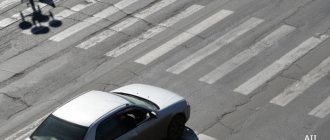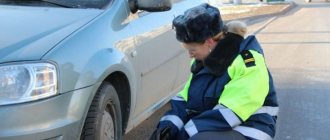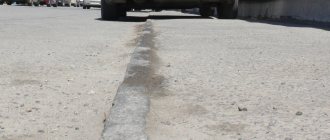Why use a child seat
In an accident, the child will survive. In a traffic accident, an unbelted child can be seriously injured or even die. Crash tests prove this.
The most serious injuries can occur to a small passenger if he sits in the middle of the rear seat. If the car hits an obstacle, the child will fly out onto the track through the front window of the car or hit the dashboard. The chair will hold him in place and he will remain intact.
The driver will not be punished. By law, a child under seven years of age is transported in a child car seat. If the child does not have such a seat, the driver will be fined 3,000 rubles.
Children will not distract the driver. From about a year old, the child begins to actively interact with the world around him - grab, press, taste. Sitting still is boring, but the switches, buttons and levers inside the car are very interesting for the baby. All this can distract the driver from the road situation and lead to an accident. In a chair, the child is limited in his movements.
Rules for transporting children in a car: traffic rules 2021
Despite the apparent rationality of this issue, there are a number of issues that are not taken into account by law and are subject to constant criticism.
And among these nuances the following can be distinguished:
- It is not clear how disabled children can be transported in a car seat;
- Why can a driver who has already been punished once in 1 day and is forced to drive further be stopped by any inspector and issued a fine a second time? This is completely out of the realm of fantasy. How can a person buy a car seat in a few hours, especially if he is traveling on the highway;
- What should drivers who own old vehicles that do not have seat belts to secure a car seat do?
The questions have remained open for many years and so far no one has been able to solve them.
- Car loans
- All about OSAGO
- All about CASCO
- Car insurance
- Car taxes
- Road accident - what to do?
- All about carsharing
- Fines
- Registration actions
- Communication with the traffic police
- To help drivers
- Calculate transport tax
- Calculate OSAGO
- Calculate CASCO
- Calculate car loan
- Calculate fuel consumption
- Car customs clearance calculator
The transportation of children in vehicles is also regulated by clause 22.9 of the Road Traffic Rules of the Russian Federation.
This paragraph clearly states that when driving with a child in a car, special structures are used, which include:
- seat belts;
- boosters;
- car seats;
- pillows.
The design should be selected taking into account the age category and weight of the children.
At what age is it necessary to transport children in special seats?
Even newborns are required by law to be placed in a special car seat.
Until the age of seven - in a chair. As required by law, children under seven years of age are seated by the car owner in a seat that corresponds to their weight and height.
The chair can also be placed on the passenger seat in the front. One condition - turn off the airbag if you place the seat backwards. The button is usually located on the side of the glove compartment - near the door hinge. This is necessary so that the deployed airbag does not throw the seat along with the small passenger. This is written in the car manual.
From seven to eleven years old - in the back seat. A child over seven years old is allowed to ride in the second row without special devices. A standard seat belt will suffice.
A sticker next to the front airbag deactivation button shows what will happen to the seat and baby when the airbag is activated.
What are the downsides to car seat laws?
Most often, difficulties with the law on child seats arise in large families. One car can comfortably accommodate two, rarely three, seats, but without them all four or even five children could fit in the back seat.
Another drawback is the imposition of fines on taxi drivers. Sometimes parents deliberately do not warn that there will be a child in the cabin, so as not to increase the cost of the trip. When an inspector stops a car, the blame falls on the taxi driver. In extreme cases, the fine for parents will be 3,000 rubles, and for the driver – 25,000.
Types of child restraints
Manufacturers divide child seats according to the height and weight of the child. There are four groups in total:
- for a child up to one year old,
- up to seven years old,
- from seven to twelve years old,
- after twelve years.
From left to right: cradle up to twelve months, chairs up to seven years and from seven to twelve years
This booster is for children over seven years old. It is designed so that the child sits higher - so the straps will lie on the chest and not on the neck. It costs less than a seat, but the UN is against placing children under 125 cm and weighing less than 22 kg on a booster.
Types of chairs
Types of car seats for children on the Russian market:
| Child's age | Restraint type | Weight in kg. | Group (class) car seats |
| from birth to 1 year | Carrying or “cradle”. They are installed in the car in one of two positions: horizontal, in which the child can sleep in the car, vertical, in which the baby is held using a special belt. | to 10 | 0 |
| up to 1.5 years. Can be used for children from the first day of life. | Armchair. The child in it is in a “reclining” state. The device can be positioned either with your back or facing the direction of travel. | up to 13 | 0+ |
| from 1 year to 4 years | Armchair. Installation can only be done in the direction of travel of the vehicle. The child is secured using durable, five-point harnesses. | 9-18 | 1 |
| from 3 to 7 years | Armchair. Standard seat belt. The chair has an adjustable backrest that can be adjusted to the height of the child. | 15-25 | 2 |
| from 7 to 12 years | Seat without backrest. The child is held in place by an additional seat belt. | up to 36 | 3 |
Each type of seat is used only for children of a certain age. Some car seats, for example, categories 0 and 0+, are adjustable depending on the child’s height and weight, but from 1.5 years old it is necessary to purchase a larger seat.
Finding a child in a chair that is not suitable for him is equivalent to the absence of a device.
Discounted fine for transporting children without a seat
There is a rule that works with all administrative fines. If the driver agrees with the decision and does not plan to appeal it, he has 20 days to pay with a 50% discount. Instead of 3000, the driver will pay 1500 rubles. The period begins from the date of the decision. The date can be viewed on the paper order if you received a regular letter.
To avoid going to the post office, check the fine and pay at a discount on the Traffic Police Fines website.
Under the payment button there is information about the period during which the discount will be valid
Fine for ordinary people, officials and legal entities
The fine for not having a child seat varies depending on who committed the offense:
| Responsible person | Amount of fine in rubles |
| Driver (Parents, relatives) | 3 000 |
| Officials – educators, teachers, taxi drivers | 25 000 |
| Legal entities – school, taxi company | 100 000 |
It is possible to pay the fine with a 50% discount within 20 days from the date of delivery of the decision to the citizen.
Is it possible to ride in a taxi without a child seat?
No, a taxi is the same car, and it can also get into an accident. In taxi ordering applications you can order a car with a child seat. For example, Citymobil and Yandex.Taxi make it possible to select it according to the child’s weight.
This is what Citymobil's choice looks like
Yandex.Taxi also has a choice of seat type
Taxi fine if child is without a seat. If a traffic police officer stops a taxi and a child is riding in it without a special seat, the director of the taxi company will receive a fine of 100,000 rubles. If people were injured or killed as a result of the taxi ride, the director will receive a more serious punishment. This is a fine of up to 500,000 rubles or up to 6 years in prison with a fine of up to 500,000 rubles.
Rules for transporting children in a car in 2021
If the question arises whether it is possible to transport a small child in your arms, it is worth reading clause 22.9 of the Russian Traffic Regulations, as amended. The rules here are the same as for children under one year of age, provided that there is a device that matches the weight and age of the baby. Passengers under 7 years of age and older are allowed to travel if standard seat belts or a system with the Isofix mark -1 are provided.
The law on transporting children in a car states: it is permissible to transport a child in the front seat if there is a standard restraint element. If a small passenger is in the back seat of a car or truck cab, he must be fastened with seat belts or be protected by a securing device.
It is not necessary to buy a separate seat - you can make it yourself for free, in compliance with the requirements of traffic rules for transporting children, depending on the year of birth. The created accessory will protect the little passenger if the design meets all the necessary requirements.
If you have doubts about a homemade device, it is better to buy a factory analogue. The child can be involved in choosing a child car seat. This helps to purchase the most comfortable model, taking into account anthropometric data. You should not buy an accessory “for growth”. The operation of such products does not give the desired effect. Among the main selection criteria are the types of fastenings and methods of fixation.
Without special devices, transporting children in a car in the front seat is allowed from 12 years of age. The child's height must be at least 1.5 meters. For safety, it is necessary to use standard securing straps, adjusting them accordingly.
The table shows the official standards for children's car safety devices, in accordance with the law and the requirements of the State Traffic Safety Inspectorate.
Law enforcement officials can impose fines not only for the absence of a child seat, but also for improper installation of the accessory, or violation of the norms for accompanying children at night. The seat is not allowed to be installed upside down. This contributes to serious injury or death as a result of an accident or emergency stop.
Alternative to child car seats
It does not exist either from a legal or security point of view. Stores sell pads that hold the belt on the child's chest, preventing it from moving to the neck. But they do not have a safety certificate.
Only seats have a certificate - this is proof that they have passed all the necessary tests and can carry a child in them. Proof of such checks is an orange sticker on the chair:
The inspector will equate the absence of such a sticker with the absence of a chair.
These belt covers are called differently by different sellers: corrector, belt adapter or child restraint with a strap. They cannot be used - crash tests prove this. Photo from market.yandex.ru
How to choose a car seat manufacturer
It is almost impossible to cancel the sanction for the absence of a car seat when it is required by traffic regulations. A simple rule applies here - either it is there, and the passenger in it is fastened with the provided belts while driving, or it is not there. But the driver still has 10 days to file a complaint.
A monetary penalty will also be imposed in the following cases:
- if a minor passenger is fastened, but is not in a special seat, but in the arms of an adult;
- the retention system is not suitable in size or does not comply with GOST (for example, it is too small);
- the passenger in the car seat is not fastened with seat belts;
- there is more than one minor passenger in one seat;
- There are no standard seat belts in the rear seat where the seat is installed.
In the latter case, the seat should be installed on the passenger seat next to the driver.
It is important to note that if more than one child is transported in the car without a seat, then the fine will not be multiplied by the number of minor passengers. The final amount of punishment is determined taking into account Part 3 of Art. 12.23 Code of Administrative Offences.
Answers to the list of main points by which independent studies evaluate chairs will allow you to choose the appropriate option:
- build quality and material used;
- chair equipment;
- ease of fixing the chair on the car seat;
- safety and convenience;
- crash test results;
- how securely the child is secured in the car seat;
- availability of additional security measures;
- ease of use and maintenance.
Based on these parameters, ratings of manufacturing companies were compiled that produce reliable and high-quality restraint devices for transporting children of different ages. These include: Kiddy, Recaro, BeSafe, Bebe Confort, Britax-Romer, Maxi Cosi, Cybex, Nania, Aprica, Coletto.
One of the most important points when choosing is the comfort of the child’s travel. That is why it is better to choose a child seat together with him - he is able to evaluate the comfort and design of the seating device. By joint decision we can choose the most optimal option.
Remember
- It is prohibited to transport children under 11 years of age without a special seat. Even in a taxi, parents must order a car with a seat.
- The fine for a driver for transporting a child without a child seat is 3,000 rubles. For the director of a taxi company, the fine is stricter - 100,000 rubles.
- If people, including children, were injured in a taxi, the director will receive a fine of up to 500,000 rubles or even a prison term of up to 6 years with a fine.
- It is almost impossible to appeal a fine for driving without a child seat, because it is easy to prove from a photo of the violation - either the seat is there or not.
- The fine can be paid at a discount in the first 20 days from the date of the decision.
All articles by the author: Evgeniy Lesnov
What is the penalty for transporting several children without car seats?
Transporting several children who are under twelve years of age and under the required height and weight without additional safety devices is considered one offense. The punishment for it is not cumulative based on the number of children and is equal to the sanctions for the absence of a child car seat (3,000 rubles).
Fine for a child without a child seat in a taxi
If a traffic police inspector stops an ordinary driver who is transporting a small child in his car without a seat, then he faces liability under Article 12.23 of the Code of Administrative Offenses and a fine of 3,000 rubles.
It’s another matter if such a violation is committed by a taxi who is engaged in his activity professionally and has the appropriate permits and travels in a taxi car.
In this case, the driver may be charged under Article 238 of the Criminal Code of the Russian Federation - “Provision of services that do not meet the requirements for the safety of life or health of consumers.”
- Under the first part of this article, you can receive a fine of up to 300 thousand rubles , or restriction of freedom or even imprisonment for up to 2 years.
- According to the second part of the same article, if the case involved children under 6 years of age, or the consequences were the infliction of serious harm or the death of a person, the sanctions for the driver will be even tougher. The fine for a child without a car seat in a taxi is from 100 to 500 thousand rubles , or imprisonment for up to 6 years (!), with a fine of up to 500 thousand rubles.
- Part three of Article 238 of the Criminal Code of the Russian Federation is the most stringent and is applied if, for example, an accident results in the death of two or more persons. Sanction: up to 10 years in prison.
That is, if, for example, a taxi driver has an outstanding criminal record, and if he is caught violating Part 1 of Art. 238 of the Criminal Code of the Russian Federation (simply transporting a child without a seat), then the judge can easily send him to jail, according to the law.
Even worse, if an accident occurs (even if the taxi driver was not at fault, they drove into him) and it turns out that the taxi driver was transporting children with disabilities, and they, God forbid, were injured, the corresponding article of the Criminal Code will inevitably be applied to the driver.
How can a traffic police inspector check for the presence of a car seat?
Many people are familiar with the situation when an inspector opens car doors on his own to check whether passengers are wearing seat belts and/or whether children are in child car seats.
Of course, this is illegal - the Administrative Regulations of the Ministry of Internal Affairs describe any procedure for identifying an offense and prescribes for most of them (except visual) its own procedure, including a preliminary appropriate protocol. In this case, in order to open the doors, the inspector needs to draw up an inspection protocol with the relevant grounds included in it, a video recording or an invitation to two witnesses.
But more often than not, the inspector himself asks the driver to open the door in a demanding tone. In this case, he again only asks, and the request can be refused . If he requires this, then ask under what administrative procedure such a requirement was made. However, of course, it is always better to open the doors if there is no violation on your part.
Types of devices for the safe passage of children in motor vehicles (car seats and analogues)
Standards for safe travel in a child's car require that the child be secured in the seat. Fixation using standard seat belts, due to the physiological characteristics of the child, is not always sufficient and safe. Requires the use of additional funds.
Depending on the height, age and weight of the child, a classification of means for safely transporting a child in a car has been developed, ECE – R 44|03:
- Group “0” – children aged from birth to six months, weighing up to 10 kg;
- Group “0+” – children aged from birth to one year, weighing up to 13 kg;
- Group “1” – children aged from 1 year to 4 years, weighing from 9 kg to 18 kg;
- Group “2” – children aged from 3 to 7 years, weighing from 15 kg to 25 kg;
- Group “3” – children aged from 6 to 12 years, weighing from 22 to 36 kg.
Classification ECE – R 44|03 has been developed and used in European countries. Recognized as valid on the territory of the Russian Federation.
Group “0” (infant seat)
Intended for children up to six months of age. Attached to the seat at right angles to the direction of vehicle movement. Conventional seat belts or devices designed to secure the infant seat are used as fastenings. Installation in the front seat is only possible if the airbag can be disabled. (Otherwise it is prohibited).
Group "0+"
A car seat in which the child will be in a semi-sitting position. Fixed to the seat using special fasteners or seat belts. Equipped with its own seat belts to secure the child. Installed against vehicle traffic. Used for the safe transportation of children under 1-1.5 years of age. Install on the front seat only if the airbag can be deactivated. Otherwise, installing a child seat in the front is not permitted.
Group "1"
A car seat designed for children aged from 9-12 months to 4 years. Installed on the front or rear seat, in the direction of travel. Fixed using car seat belts or special fasteners. Equipped with its own seat belts.
Group "2"
A device that ensures the safety of a child in vehicles using an adjustable backrest or headrest. The child is secured using car seat belts passed through the guide slots of the device. Installed in the direction of vehicle travel.
Group "3"
Devices that ensure the safety of a child under twelve years of age whose weight or height does not allow the use of standard seat belts. Equipped with its own seat belts. Can be placed in both the front and back seats.
Universal car seats for children, their advantages and disadvantages
Universal chairs combine several groups at once. For example, in the category “1/2/3” the following groups are combined: “1” (9-18 kg), “2” (15-25 kg) and “3” (22-36 kg). On average, they cover the age period from 9 months to 12 years. That is, having moved from the car seat, the child can remain in one seat until it turns into a booster.
universal car seat from 0 to 36 kg
The advantage of universal restraint devices over standard models is obvious - extended service life. The seat will “grow” with the passenger, and you will not need to replace it when the baby moves to another age group.
The disadvantages include ergonomics that are common to children of all ages. It is impossible to please every age group 100%, so each “suffers” in its own way. For example, kids can be capricious because of an uncomfortable headrest, which can be too high even in the maximum lowered position.
How can a traffic police inspector check for a child in a car?
It’s very simple - by visual inspection through the car windows; if the car windows are tinted, then the inspector may ask you to lower them.
But the situation familiar to many drivers with the unauthorized opening of the door by an inspector to check the rules for transporting children is illegal. A police officer can do this only in the presence of invited witnesses or using video recording, having previously drawn up an inspection report.
If you do not violate anything, it is better to comply with the inspector’s request to open the door or lower the window. You will simply lose more time if the traffic police officer decides to carry out the inspection procedure in accordance with current legislation.
The State Traffic Inspectorate often carries out preventive measures with names like “child in the car” - the traffic police crew is located in the morning hours near a kindergarten or school and “works out” all approaching cars. And this is correct, no matter how it sounds.
More on the topic: What happens to driving without a driver's license?
Legislation
Specific, stricter requirements for transporting children by vehicle appeared in Russia in 2007. In the West they have existed for 30 years - Europeans and Americans never think of transporting a child in a car without a child car seat. They are motivated not by the threat of a fine, but by the safety of the child.
In 2007, for the first time in Russia they started talking about child restraints for cars, and drivers began to be required to use them. True, everything started sluggishly - the threat of a fine of 500 rubles did not motivate motorists to purchase an expensive device. Traffic police officers did not find fault with the lack of a child seat.
By 2013, the level of child mortality in road accidents remained the same. The government understood that measures need to be tightened. Article 12.23 “Violation of the rules for transporting people” was added to the Code of Administrative Offenses of the Russian Federation. A 3rd part has appeared, regulating the issues of transporting children in a car. The fine increased sixfold to 3,000 rubles.
In 2021, the rules were partially changed again.
The most basic amendments:
- leaving a child under 7 years old alone in the car costs from 500 to 2500 rubles;
- It is allowed to transport children from 7 to 11 years old without a child seat, but only when fastened in the back seat;
- Children under 12 years of age are prohibited from being transported on motor vehicles;
Amendments to the legislation are planned in the future. The rules may become stricter. There are still many careless parents on Russian roads, relying on chance.
Car seat
Child car seats are special restraint devices designed to safely transport small passengers..
They are intended for children from birth until they reach a height of 150 cm or a weight of 36 kg. Their use is not a wish, but a requirement that must be fulfilled.
The main function of a car seat is to secure the child and keep him safe from injury in accidents. Please note – child car seats save children’s lives in 75% of cases!
There are several groups of child seats:
- seats corresponding to a certain weight category;
- transformable car seats that can “grow” with your child;
- as well as seats that differ in the method of fastening in the car.
Watch a video about choosing a car seat for child safety:
Up to what age is it necessary?
TIP : Pay attention to the type of seat you buy for your child. We have already said that it should correspond to the height, weight and age of your children. Upon reaching 12 years of age, a child can travel in a car without a special child car seat. The fastener can be a regular seat belt. This age is indicated in clause 22.9 of the traffic rules.
Please note: if your child is over 12 years old, but is less than 1.5 m tall, use a booster or car seat! A regular seat belt can only be used if the height is at least 1.5 m - only in this case will it protect your baby from injury!
Correct fixation of various fasteners
Different fastening methods are used for different age categories.
Let's look at them:
- Group 0+ (0-13 kg) : for babies in this age category, use the internal three-point belt. It passes over the child's shoulders and is fixed between the legs. Thanks to this fixation, coupled with high side walls, the child is reliably protected even in the event of side impacts.
- Group 0-1 (13-18 kg): For children in this group, use an internal five-point harness. It goes over the baby's shoulders and hips.
The lock and the belts themselves must be at the pelvic level. Please note: if the lock is near the child’s stomach, then in the event of an accident it can injure the baby.These car seats are designed for children who can already sit. They have less inclination than cradles, but the side walls do not protect the entire body from impact. Please note that in this case the baby needs additional lateral support!
The five-point harness should secure the child at pelvic level. Thus, the belt will help protect the child from displacement in a side impact.
- Group 1/2/3 (18-25 kg) : Use a regular seat belt to secure the car seat.
The main condition is that the standard tape must pass through the guides at the headrest, as well as on the bottom of the child seat. The belt itself should be located over the baby's shoulder and hip. Internal harnesses are designed for children weighing up to 18 kg. And the standard belt is already able to withstand loads many times greater. - Groups 1/2 (from 25 kg) : use the internal five-point harness as well as the standard belt.
Universal car seats allow you to transport children up to 18 kg - they cannot bear a heavy load. Once your child weighs more than 18 kg, use a regular seat belt. - A car seat is a special child seat, intended for babies from birth to one year. It has a special orthopedic shape and is equipped with seat belts. It is designed to protect your baby from shock and injury.
There are two categories of infant carriers:- Category 0 – used from birth and up to 13 kg.
Category 0+ is intended for children under 1.5 years old.
- A booster is a car seat without a backrest.. It allows the child to be raised to a higher level, allowing the use of a regular seat belt. Please note that the seat belt will only work if it is resting on your shoulder.
The booster is used for children weighing from 15 to 45 kg. This device is designed exclusively for placement in the back seat of a car.Typically, boosters do not stay in place on the seat. Even though the lower part of the belt is located under the armrests, it is not safe enough. The best fastening of a child booster is a rigid fixation with the Isofix (European) or Latch (American) systems.
Pay attention to the height of the armrests - if they are high, it will be possible to place the seat belt higher. This will reduce the load it puts on the baby, including on the legs.
It happens that the booster kit includes fastening tapes with loops. They are designed to pull the standard belt away from the face. Crash tests have shown that such hinges often jump off, break and do not perform their function.
The weight of such a device is about 5 kg. They also have a special handle for carrying the baby. Some types of child car seats can even be attached to the stroller chassis, which is convenient.
IMPORTANT : According to traffic regulations, you cannot install a car seat on the front seat of a car if it is designed for rear-facing mounting.
How to choose a car seat manufacturer
In 2021, deputies of the State Duma are going to amend the traffic rules and other legislative acts of the Russian Federation, which will regulate the classification of car seats for children according to their age. As reflected in the bill, car seats will be divided into the following categories:
- Category zero implies the use of infant carriers for children weighing from 1 to 10 kilograms and or up to one year of age. In such bassinets, babies are secured with a wide strap or a three-point belt. In addition to the recumbent position, car seats in this category provide a semi-recumbent position for the baby.
- The first category is for children weighing from 10 to 18 kilograms, or ages from 1 to 4 years. These seats are designed to secure the child with a five-point harness.
- The second category of seats is used for children weighing from 16 to 25 kilograms or ages from 4 to 7 years. In this case, the small passenger is secured using the vehicle's seat belts.
- The third category of car seats is designed for children from 7 to 12 years old or weighing from 25 to 38 kilograms. The difference between cradles of this category is the presence of a removable backrest and a limiter for the upper strap of a stationary car seat belt.
It is worth saying that if these additions come into force, the traffic police officer may impose an administrative penalty on the driver of the car if the child is in a car seat of the wrong category. At the same time, as the “servants of the people” promise, the fine for such an offense will be from 800 to 1200 rubles.
We invite you to read: On the approval and implementation of the staffing table
Especially for newborns and those children whose age does not exceed one year, manufacturers offer infant carriers of group “0”. They are designed for small passengers weighing up to ten kilograms.
For children who have outgrown the zero group, other restraint devices of class “0” are offered. They are designed to weigh no more than 13 kilograms.
If a child weighs up to 18 - 20 kilograms, then it is recommended that he take a category “1” chair.
For older children, group “2” chairs are provided. They are made with the expectation that the passenger’s weight does not exceed 25 kilograms.
For other children, car restraint devices of group “3” are produced, designed for a weight not exceeding 36 kilograms.
Penalties for incorrect installation
Do not think that monetary penalties are imposed only for the lack of a child seat. It is equally important to securely fasten the structure.
What the fine is for:
- The seat is positioned backwards in relation to movement. In case of sudden braking and an emergency situation, such an installation provokes severe injuries and death.
- The device does not correspond to the age and weight of the child. You need to choose an item in the store together with your offspring, actually trying on a chair.
- If the baby has outgrown the old structure, it is necessary to purchase a new one in the near future. Often children who have reached the age of six months and older continue to be carried in a cradle. But the baby is clearly cramped in it. And this also negatively affects the condition of the skeleton.
The legislation regarding child car transport devices has not been revised since 2021. It is possible that the standards will soon be adjusted, despite complaints from drivers about the pickiness of traffic police officers. It must be remembered that we are talking about the life of a child, for whose health serious consequences can occur even as a result of a minor injury.
Basic rules for transporting babies in a car
You will have to choose a place where your child will sit in accordance with his age. Children under 12 years of age can generally travel in a car only if safe conditions are created. What does this mean - let's look further.
- Only children aged 12+ can be transported in the front seat. In this case, it is necessary to place the child in a special child restraint seat. Consider the age, height and weight of the child - the chair must match their characteristics.
Nowadays the choice of children's car seats is huge - do not skimp and choose the device that is ideal for your child. After all, this is a matter of life. Regular seat belts are designed for adults - do not use them for your child!Any even the slightest sudden movement of the car can cause serious injury. Imagine that in this case, even a speed of 20 km/h already poses a serious danger for a child if the baby is fastened with a belt intended for an adult.
- Children up to 12 years old can be transported in the back seat . In this case, age must be taken into account. So, if a child is under 7 years old, then he can be transported exclusively in a child car seat. If the child is between 7 and 12 years old, then you can also use a regular seat belt.
So: you can carry a child over 12 years old in the front seat. The younger category of children should be in the back. In any case, fix the child’s position strictly in accordance with traffic rules.
IMPORTANT : Be extremely careful: as studies show, a regular seat belt is placed at the level of the child’s neck - this threatens to cause serious fractures in an accident, or even much more tragic consequences. A regular seat belt should be at chest level - this is the best option.
If you are carrying a child over 12 years old in the back seat, use a seat belt. A regular child seat is no longer suitable for this age group . Therefore, you can safely fasten your children with an adult seat belt - the main thing is that your child’s height is 150 cm or higher.
Child restraints are devices that are specifically designed to safely transport your child.
Where can you find articles aimed at convincing vehicle drivers about the need to have a child seat in the cabin? We find the first mention in the traffic rules - in paragraph 2.1.2 of the traffic rules it is stated that if a vehicle is equipped with seat belts, then all its passengers, including the driver, are required to ride with their seat belts fastened .
There is a fine for violating this clause. We read about this in Art. 12.6 of the Code of Administrative Offenses: “Driving a vehicle by a driver who is not wearing a seat belt, transporting passengers who are not wearing seat belts, if the design of the vehicle provides for seat belts... – entails an administrative fine in the amount of one thousand rubles.”
One thousand rubles is a considerable amount, but at the same time it allows drivers to understand that jokes involving non-compliance with traffic rules are punishable by law. If a driver refuses to respect the rules of the road, the law will force him to do so.
The main task of a car driver is to ensure the safety of passengers. Read our articles about the fine a driver faces for violating the rules for transporting people:
- in the back of a car;
- in a cargo van.
Driver convenience
Are there only the driver and the child in the car?
Expert opinion
Natalia Balashova
Experience as a forensic expert in the field of automotive technical examination for more than 2 years, more than 3 years of work in the field of insurance disputes, appealing guilt in road accidents
Ask a Question
It is especially important that the baby is comfortable and safe, without distracting the driver. When a small passenger is not fastened and moves freely around the cabin, the parent is distracted from the road, trying to make sure that everything is fine. There is a great threat to the safety of both. When the child sits in one place, the driver can concentrate on the road, knowing that the baby is not in danger.
Child's comfort
Modern car seats are designed for maximum comfort for the little passenger. Simply sitting or sleeping in a special soft device is much more comfortable than just sitting on a car seat.
The chairs allow you to comfortably accommodate newborn babies, and the mother does not need to hold him in her arms during the trip. Many seats can be disassembled, so you don’t have to wake up your sleeping baby at the end of the trip. Parents take him out of the chair along with the cradle and take him with them.
How can a traffic police officer ensure that children are transported correctly?
Traffic police officer
An officer can punish for the incorrect transportation of children on any road if he stops the driver. He has the right to check compliance with all rules and, if he deems it necessary, impose a fine.
Raids are organized especially for the safety of children. They may coincide with holidays: the first of September, graduations, the beginning of vacations. Inspectors conduct such checks near schools, kindergartens, and children's entertainment centers.
It cannot be said that this measure is intended to impose a fine for the sake of a fine. Child safety is a very important measure on the road. By their actions, inspectors only encourage everyone behind the wheel to treat the transportation of their own and other people’s children as responsibly as possible.
The punishment for incorrectly transporting children is already quite serious. It is unlikely that the rate will increase significantly in the near future. Most likely, the amount can be adjusted without interruption from all other types of punishments. If they are indexed, then this fine will increase. But at the moment there is no reliable data on an increase in fines.
Ultimately, all measures taken by road service employees, especially in the field of traffic safety on the country’s roads, are aimed at ensuring that our children grow up calmly and without problems, so that not a single driver in Russia will ever reproach himself for sparing money. on a child seat in your car.
*Prices are current as of July 2021.











